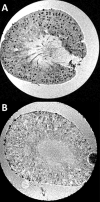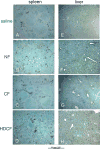Biocompatibility of ferritin-based nanoparticles as targeted MRI contrast agents
- PMID: 27071333
- PMCID: PMC4955692
- DOI: 10.1016/j.nano.2016.03.007
Biocompatibility of ferritin-based nanoparticles as targeted MRI contrast agents
Abstract
Ferritin is a naturally occurring iron storage protein, proposed as a clinically relevant nanoparticle with applications as a diagnostic and therapeutic agent. Cationic ferritin is a targeted, injectable contrast agent to measure kidney microstructure with MRI. Here, the toxicity of horse spleen ferritin is assessed as a step to clinical translation. Adult male mice received cationic, native and high dose cationic ferritin (CF, NF, or HDCF) or saline and were monitored for 3weeks. Transient weight loss occurred in the ferritin groups with no difference in renal function parameters. Ferritin-injected mice demonstrated a lower serum iron 3weeks after administration. In ferritin-injected animals pre-treated with hydrocortisone, there were no structural or weight differences in the kidneys, liver, lung, heart, or spleen. This study demonstrates a lack of significant detrimental effects of horse-derived ferritin-based nanoparticles at MRI-detectable doses, allowing further exploration of these agents in basic research and clinical diagnostics.
Keywords: Cationic ferritin; Ferritin; Kidney; Magnetic resonance imaging; Nephron number; Toxicity.
Copyright © 2016 Elsevier Inc. All rights reserved.
Conflict of interest statement
The authors have no financial, consulting or personal relationships with other people or organizations that could influence this work. KMB is the founder of NanoDiagnostics, LLC.
Figures






References
-
- Modo M, Kolosnjaj-Tabi J, Nicholls F, Ling W, Wilhelm C, Debarge O, et al. Considerations for the clinical use of contrast agents for cellular MRI in regenerative medicine. Contrast Media Mol Imaging. 2013 Nov-Dec;8(6):439–455. - PubMed
MeSH terms
Substances
Grants and funding
LinkOut - more resources
Full Text Sources
Other Literature Sources
Medical

